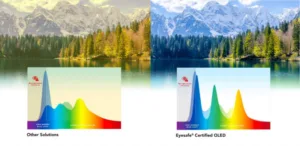Eyesafe, a global leader blue light management for the consumer electronics industry, and LG Display, the world’s leading innovator of display technologies, announced the release of a white paper entitled “OLED: TV Designed for Health”. The white paper examines the major display technologies for television, including LCD and OLED, and their potential influence on eye health and circadian rhythm.
Exposure to blue light affects sleep cycles by suppressing levels of melatonin in the brain. One of the benefits of OLED TV is its naturally low blue light emissions as compared to those of traditional LCD TVs on the market. Even while maintaining perfect black and high contrast characteristics with excellent picture quality, OLED provides the user with better eye comfort and viewing experience.
One of the benefits of OLED TV is its naturally low blue light emissions compared to traditional LCD TVs on the market.
At a recent industry conference, Dr. Vance Thompson, a world-renowned ophthalmic surgeon and professor of ophthalmology at the University of South Dakota Sanford School of Medicine, and member of the Eyesafe Vision Health Advisory Board, confirms there may be health benefits to choosing a TV with OLED technology over a traditional LCD display. With TVs getting bigger and brighter, and people spending more time overall watching TV, our blue light exposure is rising quite fast,” said Dr. Thompson, “Many studies suggest blue light exposure in the evening contributes to sleep disturbance. There are many options for customers when purchasing a TV, but OLED is a great choice because it has lower blue light, which may help with sleep, especially if you’re one of those people who enjoys watching movies late at night.”

